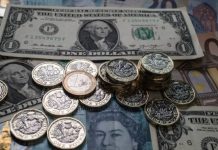
SINGAPORE: The dollar fell versus its major peers on Friday, as investors grew increasingly confident that the U.S. Federal Reserve may hit the pause button on monetary tightening this year.
Fed Chairman Jerome Powell reiterated on Thursday the U.S. central bank has the ability to be patient on monetary policy given that inflation remains stable. Markets are now pricing in no further rate hikes by the Fed this year.
Fed Vice Chair Richard Clarida also struck a dovish tone, underscoring the central bank’s willingness to remain patient on the issue of raising rates.
The sentiment was still slightly cautious in Asian trade on a lack of concrete details from the United States and China on any progress in their trade dispute after a three-day meeting in Beijing. The two sides are more than halfway through a 90-day truce agreed by U.S. President Donald Trump and his Chinese counterpart Xi Jinping.
Traders still remain optimistic that a trade deal between the world’s largest economies will eventually materialize. U.S. Treasury Secretary Steven Mnuchin said late on Thursday that Chinese Vice Premier Liu He will “most likely” visit Washington later in January for trade talks.
The Aussie dollar was last at $0.7201, gaining 0.2 percent versus the greenback, while the kiwi firmed 0.44 percent to $0.6808.
The dollar also fell 0.47 percent versus the offshore yuan to 6.7602. The yuan is now at its strongest since late July last year.
The dollar index fell by 0.17 percent to 95.37. The index has fallen around 2.2 percent since mid-December on expectations that a slowdown in growth, both in the United States as well as globally, will restrict the Fed from raising rates in 2019.
In 2018, the greenback outperformed its peers, gaining 4.3 percent as the Fed hiked rates four times on the back of a strong domestic economy, falling unemployment and rising wage pressures. This has caused traders to turn bearish on the dollar.
However, few analysts still forecast a rising dollar for this year.
The safe-haven yen strengthened 0.1 percent to 108.25 per dollar, reflecting investors’ cautious wait-and-see mode.
The euro gained 0.2 percent to $1.1519, after losing 0.4 percent of its value in the previous session. The single currency has been pressured by a slew of weaker-than-expected economic data, especially from France and Germany.
The European Central Bank is widely expected to remain accommodative in 2019, which should keep a lid on the single currency.
Elsewhere, sterling traded marginally firmer, fetching $1.2752 in early Asian trade with traders focused on the progress of Brexit.
British Prime Minister Theresa May must win a vote in parliament to get her Brexit deal approved or risk seeing Britain’s exit from the European Union descend into chaos. The vote is now due to take place on Jan. 15. The numbers are not in May’s favour and her chances of winning the vote look extremely slim.
The dollar weakened versus the Canadian dollar by 0.17 percent to C$1.3211. The greenback has lost 3.25 percent against the loonie over the last six sessions, with the commodity-linked currency bolstered by a rebound in oil prices.






